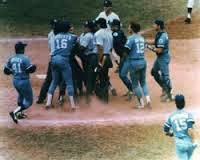
In my home office I have a picture of George Brett being restrained by teammates at home plate. The incident occurred in a game between Kansas City and the Yankees played in 1983. There was a rule in baseball that if the pine tar on your bat was too high you would be called out automatically and ejected from the game. George Brett was ejected after hitting what he believed was a game-winning ninth inning home run because his bat was covered with too much pine tar. The Royals protested the game, and the home run was later upheld, giving Kansas City a 5-4 victory after play was resumed months later. This event was called the Pine Tar Incident and is pictured above.
This brings us to the new pine tar event. Here again the Yankees are involved. However, this time the incident involved the Yankee pitcher Michael Pineda. In game two of the series with the Red Sox at Fenway Park the starting pitcher for the Yankees was Pineda. It was a very cold and windy night in Boston and Pineda had just finished a shaky first inning giving up two runs. Coming out for the second inning it was clear that he now possessed a black streak on his neck. Boston manager John Farrell approached the home plate umpire and talked to him. The umpire then walked to the mound and rubbed his finger on Pineda’s neck. The umpire mouthed the words pine tar and ejected Pineda from the game. The baseball rule enforced by the home plate umpire says no foreign substance can be applied to the baseball. It was just two weeks ago in Yankee Stadium against the Red Sox that the cameras picked up a black streak on Pineda’s pitching hand. When asked after the game what the black streak was Pineda responded it was just dirt. It was conjectured that Farrell did nothing at that time since he knew many of his pitchers also used pine tar.
Here is my take on this. After listening to and reading the comments of many former pitchers and coaches, the use of pine tar by pitchers is very common. Since many pitchers, past and present, have admitted using pine tar this is one of those rules of baseball which will not be enforced unless the pitcher makes it so visible to everyone that the opposing manager is forced to address the issue. This is exactly what Pineda did. What was Pineda thinking? Using his neck as a billboard advertising his use of pine tar forced Farrell to take an action. If Farrell did not take an action, after doing nothing two weeks ago, he would have been vilified by talk radio, the Boston press, and the Boston fans. Yes, Pineda committed two wrongs. He lied two weeks ago about what was on his hand and then advertised to everyone at Fenway Park that he was repeating his use of pine tar.
Here are two questions I ask. Do I think Pineda was attempting to cheat by doctoring the baseball? My answer is no. The cold and windy weather combined with his inability to grip the baseball in the first inning led him to use the pine tar. To his credit when the game ended he did not attempt to hide from the press. He admitted he made a mistake using the pine tar. From everything said by knowledgeable baseball people his mistake was not being discreet with the pine tar. The other question is does the pine tar affect the movement of the baseball? With the great technology available today, I am sure scientists will be able to run tests that will statistically answer this question in the near future.
Here is my solution to the problem. Similar to when the umpire allows a pitcher to go to his mouth in cold temperatures; the home plate umpire should allow a pitcher the right to replace the rosin bag with a new bag composed of a combination of pine tar and other substances which pitchers can use to improve their grip of the baseball. Of course, after about 30 games there would be no need for this special bag.
